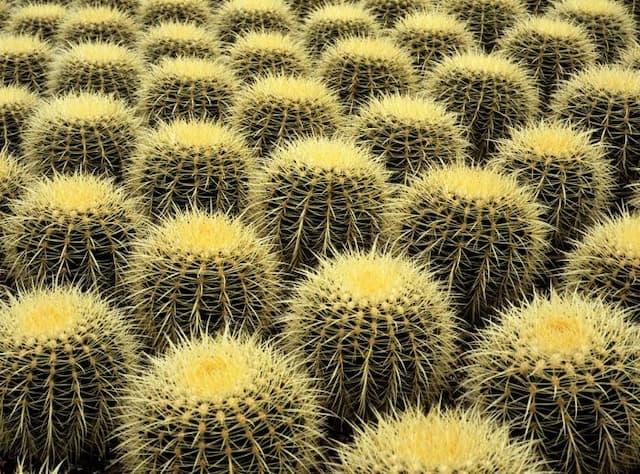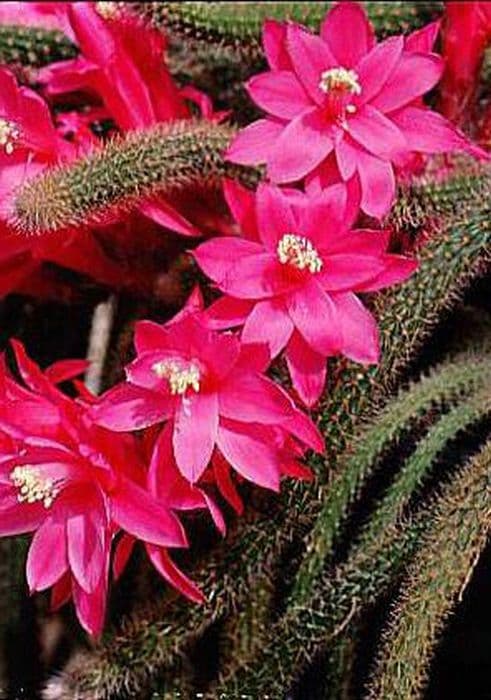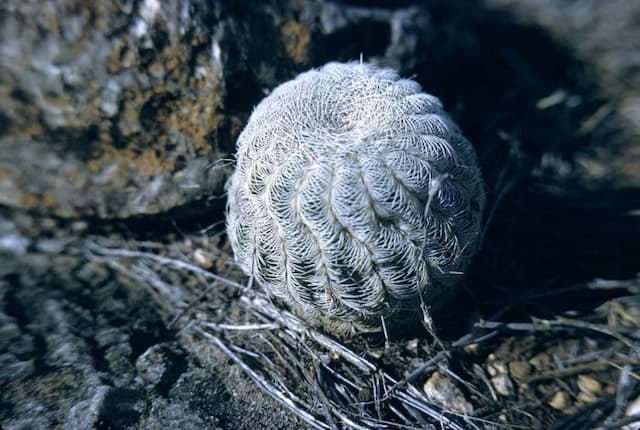Quehlians Gymnocalycium Gymnocalycium quehlianum

ABOUT
The plant known as the chin cactus has a distinctive round and somewhat flattened shape, resembling a small green ball. Its surface is sectioned into multiple vertical ridges that radiate from the top to the bottom. Along the ridges, you’ll notice small areoles, which are like little patches of wool, from where sharp spines emerge. The spines can vary in color from white to a yellowish hue or even brown, and they form a sort of protective shield for the cactus. The number of spines in each areole and their arrangement can differ, sometimes appearing more like a starburst pattern. When it comes to flowers, the chin cactus produces attractive blooms that contrast beautifully with its green body. These flowers typically emerge from the top or near the top of the cactus. They can come in colors such as white, pink, or even soft yellow, adding a pop of color that stands out against the cactus's spiny background. Once the blooming season is over, the flowers may give way to small, round fruits. The combination of the cactus's spiny ridges, woolly areoles, sharp spines, and striking flowers give it a distinctive and appealing appearance, making it a favorite among cactus enthusiasts.
About this plant
 Names
NamesFamily
Cactaceae
Synonyms
Spider Cactus, Dwarf Chin Cactus
Common names
Echinocactus quehlianus, Gymnocalycium quehlianum f. albispinum, Gymnocalycium quehlianum f. brevispinum, Gymnocalycium mihanovichii var. quehlianum.
 Toxicity
ToxicityTo humans
The plant commonly known as Spider Cactus (Gymnocalycium quehlianum) is not considered toxic to humans. There is no widespread documentation of toxicity and potential health consequences from ingesting this cactus, but it’s generally advisable to avoid consuming plants that are not commonly recognized as food due to potential allergies or unidentified compounds.
To pets
Similar to its effects on humans, the Spider Cactus (Gymnocalycium quehlianum) is not known to be toxic to pets. However, ingestion is still ill-advised due to the potential for physical harm from the spines or an unexpected allergic reaction. If a pet does ingest parts of the plant and shows signs of distress, it is recommended to seek veterinary advice.
 Characteristics
CharacteristicsLife cycle
Perennials
Foliage type
Evergreen
Color of leaves
Green
Flower color
Varies
Height
6 inches [15 cm]
Spread
4 inches [10 cm]
Plant type
Cactus
Hardiness zones
9
Native area
Argentina
Benefits
 General Benefits
General Benefits- Ornamental Value: Gymnocalycium quehlianum, commonly known as Spider Cactus, adds aesthetic appeal to gardens and homes with its unique shape and colorful blooms.
- Low Maintenance: It is a resilient plant that requires minimal care, making it suitable for gardeners of all skill levels.
- Drought Tolerant: As a desert cactus, it is highly adaptable to arid conditions and can survive long periods without water.
- Space Saving: Due to its small size, it is perfect for those with limited space such as apartments and small gardens.
- Propagation: Spider Cactus can easily propagate from seeds or offsets, making it simple to expand your collection or share with others.
 Medical Properties
Medical PropertiesThis plant is not used for medical purposes.
 Air-purifying Qualities
Air-purifying QualitiesThis plant is not specifically known for air purifying qualities.
 Other Uses
Other Uses- Gymnocalycium quehlianum, commonly known as the Spider Cactus, can be used in miniature gardens or fairy gardens due to its small and compact size, adding a unique texture and form.
- It can serve as a living gift or souvenir that represents a hobby or interest in succulents and horticulture, sharing its beauty without the need for extensive care.
- Spider Cactus can be used as inspiration for artists and photographers, providing an exotic and intricate subject for drawings, paintings, and macro photography.
- It can be incorporated in educational programs about plant adaptation and arid environments, showcasing how succulents conserve water.
- This cactus could play a role in stress relief as part of a desktop garden, offering a natural element to office spaces that require little attention.
- Gymnocalycium quehlianum can be used in drought-resistant landscaping, contributing to water conservation efforts in suitable climates.
- It can act as a natural barrier when planted in groups, deterring small animals with its spines without causing significant harm.
- As part of a collection, it adds diversity to cacti and succulent displays, complementing other plants with its unique globular shape.
- Spider Cactus' slow growth and low maintenance needs make it an ideal plant for meditation spaces or Zen gardens, contributing to a calming atmosphere.
- It can function as an educational tool for children, teaching them responsibility through caring for a living plant while being safe enough to handle when young.
Interesting Facts
 Feng Shui
Feng ShuiThe Chin Cactus is not used in Feng Shui practice.
 Plant Symbolism
Plant Symbolism- Resilience and Adaptability: Gymnocalycium quehlianum, commonly known as the Quehli's Chin Cactus, is a succulent that is well-adapted to harsh, arid environments. Its ability to store water and thrive in difficult conditions makes it a symbol of resilience and adaptability.
- Rarity and Uniqueness: This plant is relatively rare in the wild, representing uniqueness and the preciousness of natural diversity.
- Beauty and Attention: With its attractive spherical shape and potential to bloom with lovely flowers, the Quehli's Chin Cactus symbolizes beauty and the idea that attention and care can lead to unexpected and delightful outcomes.
- Self-Reliance: As a cactus, it has evolved to be self-sustaining, symbolizing self-reliance and the capacity to provide for oneself.
- Simplicity: The Quehli's Chin Cactus embodies simplicity, with its minimalist form being a reminder of the beauty and serenity that can be found in a simple, unadorned existence.
 Water
WaterThe common name for Gymnocalycium quehlianum is Spider Cactus. It is best to water this cactus thoroughly until water runs out of the drainage holes, and then allow the top inch of soil to dry out completely before watering again. This means you might water it every one to two weeks, but frequency can vary with temperature and humidity. Ensure that the pot has good drainage to avoid waterlogging. Approximately 8 ounces of water may be needed at each watering, although the amount can change depending on the pot size and environmental conditions.
 Light
LightSpider Cactus thrives in bright, indirect light—direct sunlight can be harmful, especially during the hottest parts of the day. The ideal spot for the Spider Cactus would be a south or east-facing windowsill where it receives light most of the day without the harsh midday sun. Some direct morning or late afternoon sun is beneficial, but ensure it's shaded during peak sunlight hours.
 Temperature
TemperatureThe Spider Cactus prefers temperatures between 50 and 80 degrees Fahrenheit. It can tolerate a minimum temperature of around 40 degrees Fahrenheit but shouldn't be exposed to frost. This cactus is best kept in a room where the temperature is consistent and away from drafts or heat sources that could cause sudden temperature fluctuations.
 Pruning
PruningPruning is generally not necessary for the Spider Cactus unless you need to remove damaged or diseased parts. If required, pruning should be done in the spring or summer, using sterilized and sharp tools. It's a good practice to wear gloves to protect your hands from the spines when handling the plant for pruning.
 Cleaning
CleaningAs needed
 Soil
SoilQueen of the Night cactus thrives best in a well-draining cactus mix with a pH range of 6.1 to 7.5. A mixture of regular potting soil, coarse sand, and perlite or pumice in equal parts is ideal to ensure good aeration and drainage.
 Repotting
RepottingQueen of the Night should be repotted every two to three years during its active growth phase. Choose a pot only slightly larger than the previous one to prevent excess soil moisture retention.
 Humidity & Misting
Humidity & MistingQueen of the Night prefers low to moderate humidity levels, typical of arid environments. It is best not to expose the plant to high humidity for prolonged periods.
 Suitable locations
Suitable locationsIndoor
For indoor growth, place in bright, indirect light and maintain a dry atmosphere.
Outdoor
Grow Queen of the Night outdoors in full sun to light shade and well-draining soil.
Hardiness zone
9-11 USDA
 Life cycle
Life cycleGymnocalycium quehlianum, commonly known as Quehl's Gymnocalycium, begins its life as a seed, typically requiring a warm temperature to germinate within soil with good drainage. After germination, a small cactus seedling emerges, beginning a slow growth process where it starts to form its spherical to cylindrical shape. As the plant matures, it develops characteristic ribbed stems with areoles from which spines and flowers will eventually grow. During its blooming phase, which occurs sporadically from late spring to early summer, it produces flowers near the crown of the stem, with colors ranging from white to pink. After pollination, typically by insects, it produces small, fleshy fruits containing seeds that, when dispersed, can give rise to new plants. Over the years, with proper care and conditions, Quehl's Gymnocalycium can reach its full size, continuing to produce flowers seasonally while being a long-lived cactus.
 Propogation
PropogationPropogation time
Spring-Early Summer
The most popular method for propagating Gymnocalycium quehlianum, commonly known as the Spider Cactus, is by seeds. Propagation by seeds is typically done in the spring or early summer when temperatures are warm, which facilitates germination. To propagate by seeds, one should sow the seeds in a well-draining soil mix, lightly covering them with a fine layer of sand or soil. The container with the seeds should be kept moist and placed in a warm, bright location without direct sunlight, as intense sun can impair germination. It can take anywhere from a few days to several weeks for the seeds to germinate, and during this time the soil should not be allowed to dry out completely. Seedlings are usually repotted once they have grown large enough to handle, usually one to two years after germination.









